Left Wheeler & Puppy
Edd China leaving “Wheeler Dealers” over creative differences
![]()
Edd China leaving “Wheeler Dealers” over creative differences
![]()
Top tip: Edd China, the handyman-host of TV’s “Wheeler Dealers” is stepping down to pursue other interests, he announced this week.
It’s the latest in a series of changes Discovery Channel’s Velocity network has made to the show since taking control of it a few years ago—and it’s by far the biggest.
Ant Anstead, host of the British program “For the Love of Cars” will replace China moving forward.
China doesn’t really hold back in the video posted to his YouTube channel. He praises the show’s early days and has kind words to say about the British production team and his car buying co-host, Mike Brewer, but he’s less complimentary of how Velocity continues to rework the formula.
“Wheeler Dealers” launched more than a dozen years ago in the United Kingdom with a tiny production staff and a tired 1983 Porsche 924. With a £1,000 budget, Brewer found the car and dragged it to China’s small shop. Half an hour worth of fixes later (at least in TV time), the two had a presentable front-engine Porsche that they promptly sold for £1,500. Subsequent episodes saw the stakes grow as Brewer sought out increasingly costlier and more complex cars, often to China’s mock chagrin.
But things changed a few years on as the show became more and more popular. Discovery slowly began moving China’s garage to California. Budgets ballooned—both for the show itself and Brewer’s car-buying purse—but the grassroots feel began to fade. China took on far more serious projects, the kind well out of an average home restorer’s wheelhouse. Details were glazed over and the show began to feel far more, for lack of a better term, Americanized.
“T his new direction is not something I am comfortable with as I feel the corners I was being asked to cut compromised the quality of my work and would erode my integrity as well as that of the show,” China said in the video announcement.
True, “Wheeler Dealers” has become more popular, but it is also far less relatable for hobbyists looking to pick up something cheap and learn a thing or two about fixing their cars.
Brewer told Britain’s Car Dealer Magazine that he’s “upset and gutted” about China’s decision.
“I respect his decision—Edd wants to move on to other things and I completely get that—but obviously he’s been a part of my life and has been forever so it’s a bit of a shock that he’s decided to leave the show,” Brewer said.
But China hasn’t closed the rusty car door just yet. He says that there’s more on the horizon and that he’ll continue to update his YouTube channel.
Perhaps he’ll find a way to go back to the grassroots feel that made “Wheeler Dealers” popular in the first place.
Quick Tips For Delivering Puppies

Whelping, which is what the canine birth process is called, is something that should only be handled by people with prior experience, but if you ever do find yourself having to oversee the delivery of a litter of pups, here’s what you need to know to assist.
The two most important things to remember before we go into detail, though, are these:
- The mother dog knows what to do by instinct, so she should do most of the work.
- More than at any other time, you need to heed Cesar’s advice to remain absolutely calm.
Whelping can be a stressful process for both the humans and animals involved, although dogs are usually perfectly capable of getting themselves through these things alone. Still, it’s a good idea to understand the process in case you ever do wind up overseeing canine birth.
With that in mind, here are some things that every expecting Pack Leader should know about puppy births.
The Signs of Dog Labor
Know what to look for when the time is near. After the 64 (or so) days of gestation are up, start watching for some of the following signs in your momma dog:
- She becomes restless.
- She stops eating up to 24 hours before labor.
- She may paw at her bedding, as if preparing a nest.
- She starts licking her vulva.
- She may vomit or discharge mucus.
Some vets see a drop in body temperature as a sign of impending labor while others discount it. Vets who use body temperature see a drop from a normal 101 to 102° F (38 to 39°) down to 99° F (37° C) as the indicator that birth will occur within 12 hours, while others do not think the connection is so clear-cut, so the above signs should take precedence over body temperature.
Supplies to Have on Hand
It’s important to have certain supplies on hand in order to help get the newborns and momma pup through this process. These include:
Whelping Box
A whelping box is necessary for all puppy deliveries. It’s essentially a pen where the mom can go and feel comfortable before, during, and after whelping. You can buy pre-made whelping boxes, but if you haven’t planned ahead, you can use a sturdy cardboard box with the front cut down so the mother can go in and out easily. The sides only need to be high enough to prevent any drafts reaching the pups.
A Laundry Basket Lined with a Heating Pad and a Blanket
This is for the new puppies immediately after they are born. You’ll want to get them out of the mom’s way as quickly as you can — but be sure to leave the basket where the mother can see it and the pups.
Monitor the temperature by listening. If the pups get too hot, they’ll cry, and if they get too cold, they’ll whimper.
A Stack of Clean Towels
These are to clean off the puppies if necessary.
Emergency Supplies
Sterile scissors, rubber gloves, antiseptic solution, and heavy thread or dental floss in case you need to tie umbilical cords. These items are must-haves for a few “just in case” scenarios.
Additionally, make sure you have phone numbers on hand for your regular vet as well as for an after-hours animal emergency hospital — most whelping occurs in the predawn hours.
Ready for Delivery
When you see a grayish sac drop from the vulva, this means that there’s a puppy on the way! The mother should pass the first puppy within an hour of the sac appearing. If she doesn’t, it’s time to call the vet to discuss whether to bring her in. You should also check in with the vet by phone through the entire whelping process to report its progress, generally about every fifteen minutes.
When the Mother Needs Help
Here are a few things that you might have to do following each puppy’s birth if the mother doesn’t do them herself.
Remove the Membrane
Puppies are born in a thin membrane that looks like plastic wrap, which needs to be removed within six minutes so the pup doesn’t suffocate. Normally, the mother will do this immediately. If she doesn’t, then you’ll have to break the membrane yourself.
Rub the Puppy with a Towel
Right after the membrane comes off, the mother dog will normally lick the puppy, which will stimulate it to breathe and cry. If she doesn’t do this, rub the puppy vigorously with a towel until it starts breathing on its own.
Discard the Afterbirth
Within five to fifteen minutes after each birth, a mass of blackish-green tissue called the placenta, or afterbirth, should follow. Once the puppy is born, the placenta is entirely useless. You can discard it.
The mother may try to eat the placenta. If she does, don’t worry. It’s completely natural and won’t cause her any harm, although you should not let her eat more than one or two of them.
It’s also important to keep count of the puppies and placentas, because the afterbirth does not always come out with the puppy. The mother should discharge any unaccounted for placentas after the last puppy is born.
Cut the Umbilical Cord
If the momma pup doesn’t chew through each umbilical cord on her own, you will have to cut the cord. If you do, be sure to use sterilized scissors, cut about an inch from the pup’s belly, and tie the cord off with the thread or dental floss 1/4 to 1/2 inch from the puppy’s body. When cutting, it’s better to crush the cord rather than make a clean cut; this will reduce bleeding. After you’ve tied it off, dip the end in a shallow dish with either iodine or antiseptic solution.
After Each Birth
Put the Pup in the Basket
A newborn pup will instinctively seek out the mother to begin nursing immediately. To ensure their safety, put them in the laundry basket until whelping is finished. Again, they should be where their mother can see them.
Repeat
Remember, unlike humans, multiple births (and breech births) are the norm in dogs, so the first pup will be followed by others. If you’d like an idea of how many puppies to expect, count your dog’s nipples. Usually, that will be the maximum number in the litter. Ultrasound is actually not accurate at counting the puppies in the womb, although an X-ray at about 55 days after breeding is. Depending on breed, the entire whelping process can last anywhere from two to twenty hours.
If the mother continues to have contractions without giving birth to another puppy for more than two hours, call your veterinarian immediately.
After the Last Birth
Keep Them Warm and Well-fed
Once the last puppy is born and everything seems to be going well for the mother, take her outside to urinate, then bring her and the pups into the whelping box and let them begin nursing. Now the pups need to stay warm and fed. The mother should take care of both, but if she can’t supply enough milk or rejects any or all of the puppies, then it becomes your job.
If the puppies aren’t well-fed, they’ll let you know by complaining, acting restlessly, or sucking at everything. You can feed them yourself with nursing bottles and supplements, available at pet stores.
If any of the puppies are acting lethargic, then it means they’re not warm enough. The puppies’ body temperatures should be right around 97° F (36° C). If their temperature drops below this, it’s time for the heating pad.
They should also show a steady weight gain, and you should weigh each pup often during the first few days. If it’s a large litter or you can’t tell the puppies apart, use a marking system that the mother can’t lick off to distinguish them. For example, you can tie different colored ribbons loosely around each pup’s neck, making sure they stay loose as the dogs grow.
Finally, you must take the mother to the vet with 24 to 48 hours of giving birth. This is to check for any complications or injuries. Your vet will also give your dog a posterior pituitary extract (POP) injection.
Canine whelping, like any live birth, is an amazing thing. But it can be strenuous, both for your dog and you. Hopefully, your dog’s birthing process will be simple and pain-free for every human — and every dog — involved.
Have you helped deliver puppies? Tell us your experience in the comments.
Puppy Development
Life Stages Defined
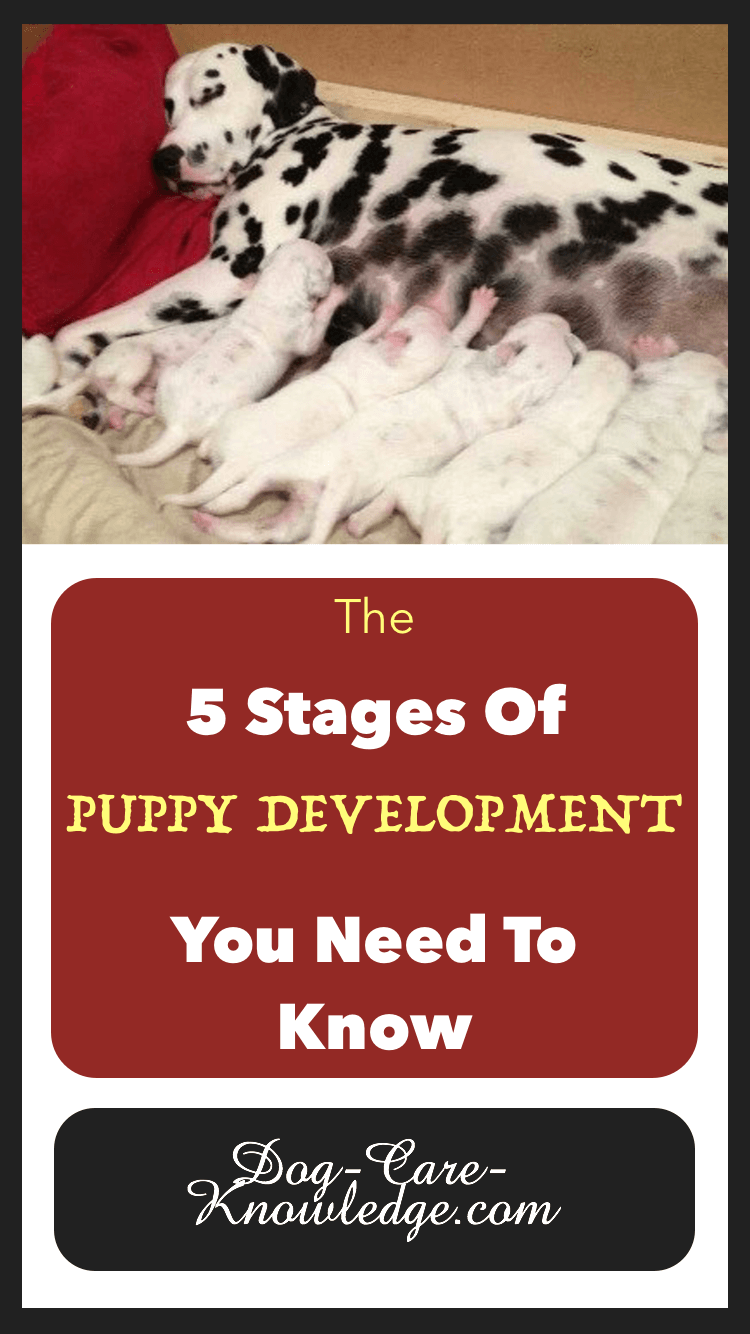
Understanding the puppy development stages will help you build the personality and character you want in your pup, which starts with training at each stage of development.
To have a wonderfully social dog, that isn’t fearful or aggressive, you need to ensure his needs are met during each phase of development.
Probably one of the most important things you can do to achieve this, is to get the right training at the right time. And that’s not just for your pup, puppy parents need training too! You need to know how to integrate your puppy into the family and establish yourself as the pack leader.
You’ll see many behavioral changes during the life stages of your pup, some of which will no doubt test you, particularly when they reach the final stage . adolescence!
Unfortunately, it is also adolescent dogs that frequently end up in shelters. Knowing how to handle your pup through each developmental stage will reduce the likelihood of him needing to be re-homed or end up in a shelter.
You can find all the information you need on training your puppy to be a social, friendly, and obedient dog with Doggy Dan the Online Dog Trainer here. Below is a brief overview of the wealth of information you’ll find on his site which has a ton of videos showing you exactly how to train you pup at every age.
Overview of Stages
The puppy development process covers five distinct stages:
- Neonatal Period at 0-2 Weeks
- Transitional Period at 2-4 weeks
- Socialization Period at 3-12 Weeks
- Ranking Period at 3-6 Months
- Adolescence at 6-18 months
Now lets look at each stage of puppy development and see what can be done to create that wonderful social dog you desire.
Stage 1: Neonatal Period at 0-2 Weeks
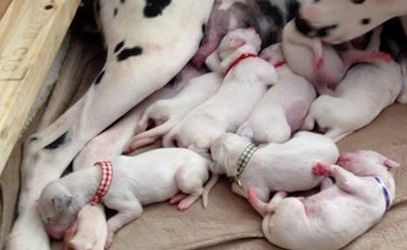
The first stage of puppy development is when they are born.
Most of us won’t have our puppies at this stage but, if you are getting your puppy from a breeder, you may get the occasional picture from the breeder.
At this age, puppies only have the sense of taste and touch and rely totally on their mother.
Stage 2: Transitional Period at 2-4 weeks
You’re still not likely to see your puppy at this age but the breeder will start to notice some more senses developing, such as their hearing and sense of smell. They’ll also start to have their puppy teeth coming through and their eyes will begin to open.
This is also the age when they start to develop their little personalities. They will interact with their litter-mates, wag their tails, stand, walk a little and are able to bark.
Stage 3: Socialization Period at 3-12 Weeks
In my opinion, this is the most important stage of a puppy’s development. It’s also the stage where the most critical changes occur, and guess what, you’re probably going to bring your puppy home during this period! Most puppies go home to their new parents at the age of 7 – 9 weeks so understanding this stage is vital.
During this period, changes start to occur rapidly, so lets break down this puppy development phase.
3-5 Weeks of Puppy Development
Somewhere between 3 and 5 weeks puppies will start to become aware of their surroundings and will have the ability to develop a relationship with people. Although you won’t take your puppy home at this age, it is important to speak with your breeder to ensure that s/he is beginning to nurture a relationship with the puppies.
This is also where you can separate the good breeders from the puppy-mill type breeders. Personally I really like to see puppies born into a household instead of a kennel or at least be around humans from the age of 3 weeks old.
Unfortunately, puppies that are from puppy-mills (usually sold in pet shops) don’t get the opportunity to develop a relationship with humans until you bring them home. This sets them back with socialization from the start and additional work is needed to enable them to become a fully sociable dog.
Puppies that are born in kennels or outside are also unfamiliar with the day-to-day noises of a regular household such as TV, vacuums cleaner, dishwasher, washing machine, phones, talking, laughing, us dropping things, you name it! You’d be surprised by how much noise we make on a daily basis and how frightening that can be to a puppy that has been raised outside.
Puppies that are brought into the home by at least 3 weeks old will take all these noises in their stride. If your pup was raised in a kennel or outside then you need to take additional steps to acclimate your pup to these new noises.
Once the puppies are at least 5 or 6 weeks old you should, if possible, ask the breeder if you can schedule a visit to see the puppies. Most good breeders recognize that the socialization period has already begun and will gladly welcome future pet parents visiting the puppies.
If they aren’t keen for you to visit then definitely ask to see some regular photo updates. What you’re looking for in the photos is evidence that the puppies are comfortable around humans and ideally that they are indoors, preferably in a household. If all you see are photos of the puppies in a kennel, or outside, then you may start off with problems with socializing your puppy when you get them home.
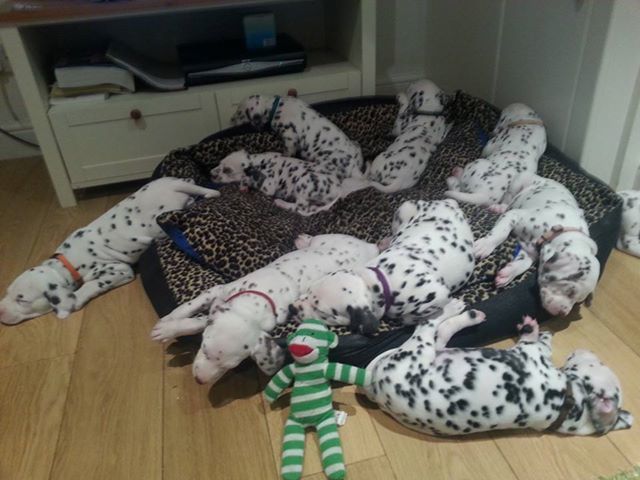
If you can’t visit, then question your breeder on what plans they have in place for the puppies to be indoors and meet new people between the age of 5-8 weeks. If they have no plans in place then I would seriously reconsider using this breeder as they are hindering the socialization period of these puppies. These puppies could easily become shy or fearful around people (and noises) which could lead to a fear aggression problem.
If you do visit the puppies at 5 weeks old you’re likely to see some fun stuff. At this age puppies are just learning to interact with each other and begin to play. They are also learning their doggie social skills as well as beginning to explore their ranking status within their pack.
Their curiosity is now starting to develop so they will be interested in you and may well nip at you as their biting skills are developing too. See here on how to handle puppy biting appropriately.
7-9 Weeks of Puppy Development
By this stage of puppy development, they will have full use of all their senses and will be ready to go home to their new owners.
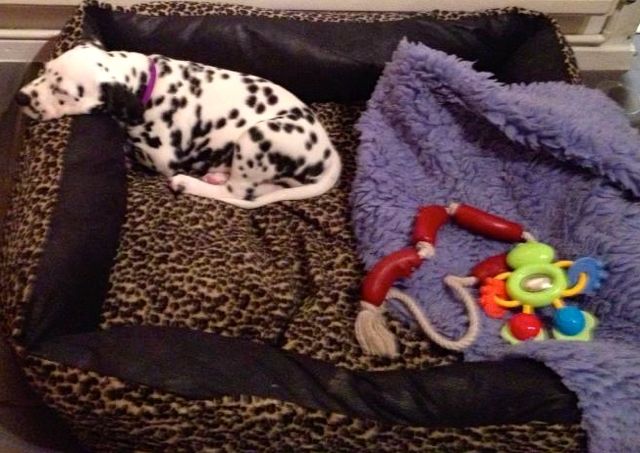
9-12 Weeks of Puppy Development
Bringing your pup home (usually between 7-12 weeks) is right in the middle of his socialization period. Therefore, it is vital that you introduce your puppy to as many new dogs, people, objects, and surroundings as you can. BUT, make sure you do so in a controlled manner. See socializing puppies for more information on how to do this correctly.
If you have another dog at home you should make sure you introduce your puppy to your existing dog on neutral territory. See more on introducing your puppy to a new dog for steps on how to do this correctly.
You can also watch some great videos on what to expect with the Online Dog Trainer here.
When bringing a new puppy home it is also important that you puppy proof your home for the sake of your puppy and your possessions! It is also a good time to start a program to get your puppy used to being left alone to avoid separation anxiety from developing.
From the age of 7 weeks, puppies are more than capable of being able to be house-trained so make sure you start them off right. See here for more information on house training your puppy.
At this phase of the puppy development, the little guys are developing their reactions to things a lot more. They are also likely to focus more on different types of people and, as long as your breeder and you did a good job initially, should be friendly and approachable to strangers.
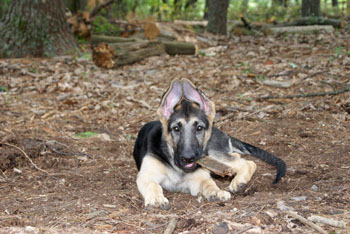
During this time they are also going to practice their biting skills a whole lot more! Previously they would play and bite with their litter-mates. Puppies will yelp when another pup bites too hard which provides feedback to that pup to bite softer. You now have to try and minic this behavior to teach your puppy not to bite. This is called bite inhibition and is quite easy to learn and teach your pups.
You’ll also notice that they may start to wander off a bit as they are more curious and will probably look to explore their environment a lot more. Be prepared for this at this age. That cute little puppy that you could take out for a potty break without a leash, now needs to be on-leash!
This is something that I noticed with my own puppy. Every morning we would come downstairs and go out the front door where she would immediately pee on the front lawn then turn round and go straight back inside. Once she hit about 12 weeks old, she would start to wander and sniff a bit before coming back in.
Then one day she saw a rabbit on the front lawn and ran off chasing the rabbit. Luckily she didn’t go far, and I don’t have traffic out front, but she did go on leash every day since that incident. At 8 or 9 weeks she would not have done that, after all, it wasn’t the first time she saw a rabbit out there. So be warned and make sure your pup is safe.
Stage 4: Ranking Period at 3-6 Months
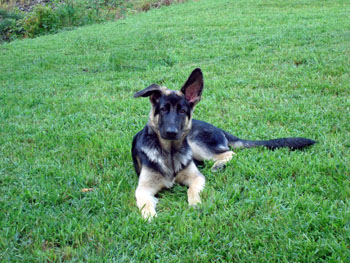
If you have another dog in your household you may start to see more ranking behavior from your puppy towards other dogs. You’ll likely see him practicing his dominance and submission skills which he may well practice on you too. If you haven’t done so already, make sure you start a training program with your pup. Its great to find a good positive training school but its also vital that you practice at home on a regular (daily) basis.
At this age your puppy is going to go through teething so watch out as chewing is a big factor at this time. Before your puppy starts chomping on your furniture:
- Don’t leave him unattended
- Make sure he has plenty of chewy sticks (bully sticks and pigs ears are best)
- Chew toys are also good (see below on how to make some yourself)
- Use Bitter Apple or Yuk which is a spray or gel that works wonders for preventing your puppy from chewing your furniture.
You may also notice that there is blood on his toys and chews or in his mouth during the teething phase. Your poor baby is hurting.
Make Your Own Canine Teething Aids
To help with the pain of teething, try soaking a flannel in chicken stock and freezing. Once frozen, this can be given to your puppy as a chew toy and will help to relieve those sore gums.
You can also get an empty sterile bone from your pet store (throw out the contents if they come pre-stuffed) seal up one end first, I usually use a piece of chicken or sausage to do this. Then blend his regular food with a small amount of chicken stock and stuff inside the bone and freeze. Again, once frozen this is a great treat for your puppy that will also soothe his gums.
Your puppy is usually done teething by the age of 6 months but you can tell when your own puppy is finished teething once you see those upper fangs (Canines) come in as they are last. Ava’s (my pup) fangs came in at the age of 5 months.
Sometimes a puppy’s tooth doesn’t fall out and the adult tooth will come in next to it. If you notice this in your pup, take him to the vet as it will need to be removed (by the vet) to prevent it from interfering with the alignment of his teeth and can also cause root infections.
Stage 5: Adolescence at 6-18 months
What can I say about the final stage of puppy development, except, hang in there, it does get better. In time.
Adolescence. Yes, your cute little puppy is going to become a teenager. He or she will start to produce hormones which you’ll mainly notice by the changes in behavior. Usually for the worse, unfortunately.
Dogs go through adolescence much earlier than human teenagers, for small breeds this could be as early as five months old, with larger dogs its more likely to be nine or ten months old.
Adolescence in larger breed dogs will likely continue until they are two or three years old with smaller dogs reaching maturity at about 18 months. Typically the bigger the dog, the slower the development.
We’ve partnered with Doggy Dan, the Online Dog Trainer, to give you access to all the training tips and problem solving skills you need for raising your puppy to become a well-adjust dog.
It also has a huge section on problems with your dog as well as behavioral problems, forums where you can chat with others and ask questions from people that are willing to help with a specific problem you maybe having.
67 Dog Puns Which Will Pawsitively Make You Howl

If you’re looking for a page with terrible dog puns, then you’re barking up the wrong tree!
Dog puns can come in many different forms. They can be simple or mind-boggling like punny jokes and may even come in the form of memes.
To get you started, we will take you through a basic guide to dog puns.
First, take a normal word and simply replace it with a dog-related word where appropriate.
For example:
Pawfect = Perfect.
Pawsitive = Positive.
Furever = Forever.
Furtunately = Fortunately.
Get the idea? Great!
Now, prepare to be impressed by our collection of 67 a-dog-able and paw-some dog puns and jokes which will have you rolling over on the floor barking.
Collection of the Best Dog Puns
What did the dog say to his wife? You are so pawfect, I will love you furever.
What is a pup’s favorite superhero? Labra-thor.

What is a dog’s favorite movie? Hairy Paw-ter and the Philosopher’s Bone, written by J K Growling.
What is a dog’s rap name? Notorious D.O.G. Notorious B.I.G was a famous American rapper. Also known as “Biggie Smalls” … or perhaps… “Puggie Smalls”… ba-dum-tish! Plenty of dog puns left don’t woffy.
Why did the dog crash? He forgot to put the car in bark. It’s safe to say that his car probably rolled over.
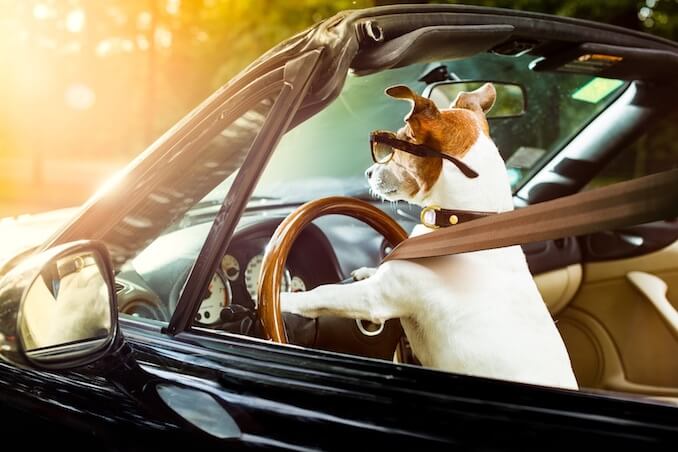
What did the Dalmatian say to the masseuse? Oooh yeah, that’s the spot!
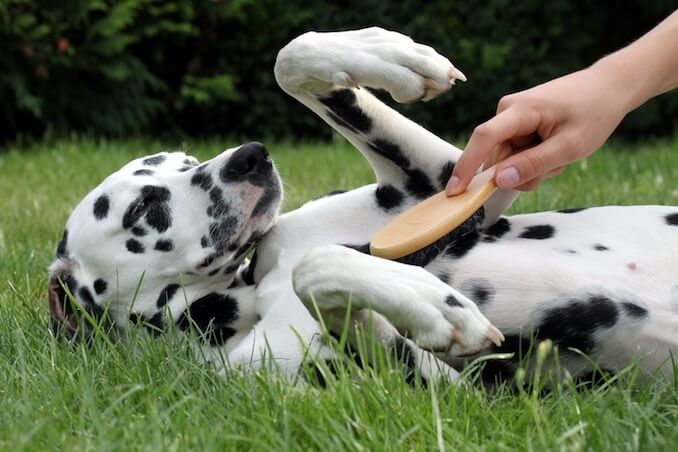
Why did the dog breeder go to the dentist? Because one of his canine’s was loose.
I got my girlfriend a puppy for her birthday. She’ll be smiling from ear terrier. A present she will truly treasure furever.
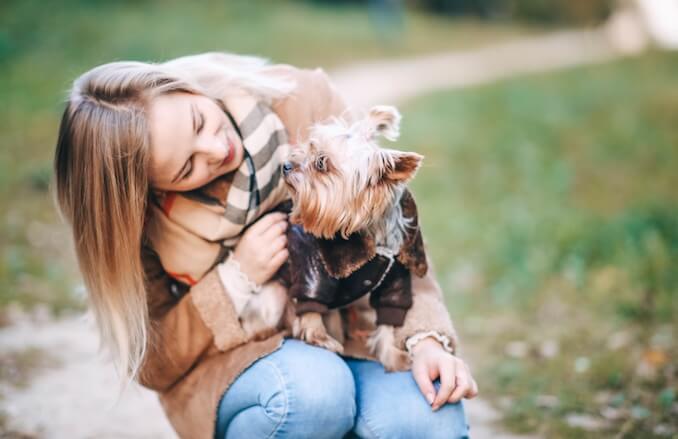
Where can I buy an intelligent pup? Near the Border of Colliefornia. Border Collies are renowned for their intelligence and are often rated the most intelligent dog in the world!
My dog loves to go clubbing. Some may say he likes to, raise the woof.
If those top ten dog puns weren’t enough, then take a look below for another 50 and our favorite dog memes!
Top Dog Memes
Is there any better way to express your love to someone than through a loving dog meme?
I’m mutts about you. 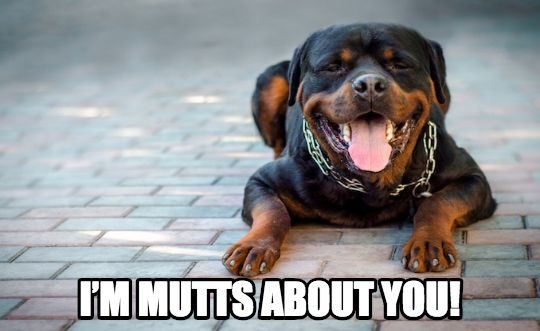
What’s a dogs favourite drink at Starbucks? A pugkin spiced latte 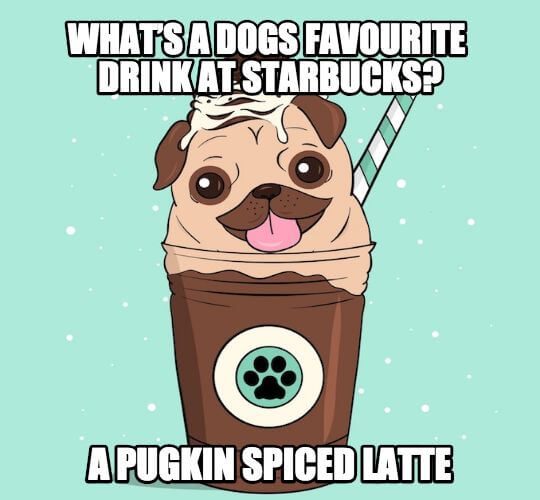
My dog looks completely different after the groomers. I guess he had a trans-fur-mation. 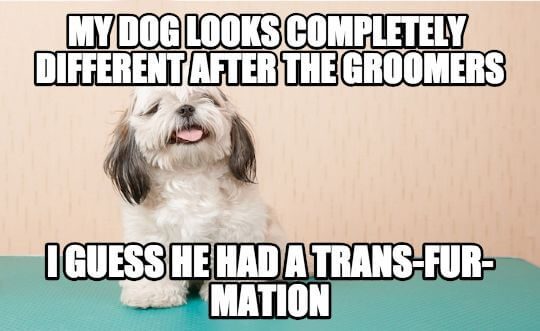
Our Favorite Dog Meme
My dog is getting promoted. He is going to be assistant branch manager. 
So, you’ve had a “ruff” day? Let me paw you a drink. 
Have you had a bad day? Just pug-get about it. 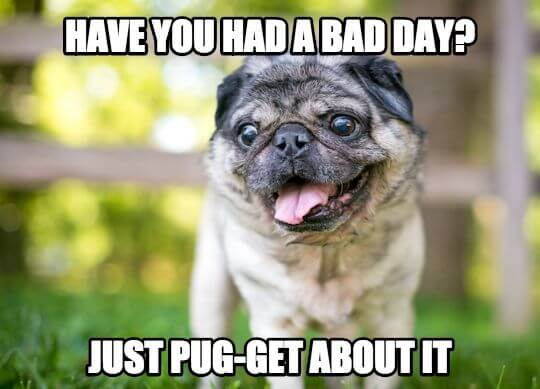
What do you call someone who doesn’t love dogs? Re-pug-nant. 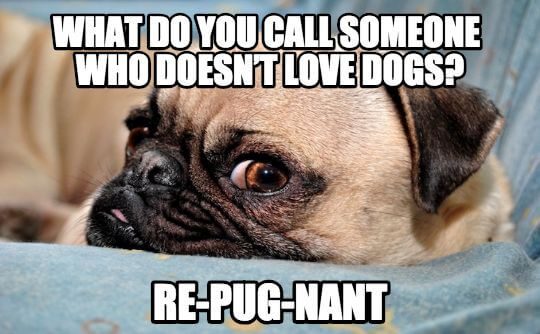
My dog’s not fat. He’s just a little husky. 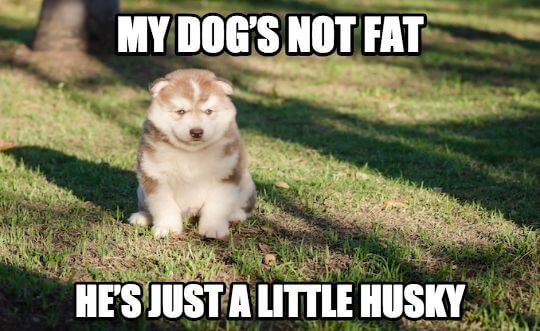
Best 50 Dog Puns and Jokes
What did the pup dress up as for Halloween? The Big Bad Woof. He actually looked rather fetching.
Why do Dachshunds lie in the shade? Because they don’t want to be hot-dogs.
Our Favorite Dog Pun
I nearly kicked my dog out. But we renegotiated the terms of his leash.
How does a Spanish dog say Merry Christmas? Feliz navi-dog.
You look like my garden. Because I really dig you.
My dog won’t get off the PlayStation He’s been playing Fi-fur all day.
Dog to Waiter: Are there any bones in this? Waiter to Dog: Yes sir, why’s that? Dog to Waiter: Because I really dig them!
Have you seen the new movie with the Dachshund? Apparently it’s an Oscar Weiner.
He’s not a bad dog. He’s just a little ruff around the edges.
My dog wants to be a tradesman. I think he wants to be a woof-er.
I went to the Veterinarian today. She really knew how to make my dog heal.
The expensive dog has gone missing. However, police are saying that at least they have a lead. Once she is found they will Retriever.
Sorry we missed puppy class. My dog was wagging. There goes his oppawtunity for pawfect attendance…
What do you call a cold dog? A pup-sicle. Better steer clear, especially if he’s fur-ocious… don’t want him to give you frost-bite.
Whenever I go to the zoo, I only ever see dogs. They were Shiht-zus. Note: Shiht-zus = Shih Tzu. A Shih Tzu is a well-known toy dog breed.
My dog’s favorite band is The Beagles.
I asked my dog why he was having a bad day. But all he said was “ruff”.
My dog is very poor. He can’t afford a “woof” over his head.
Why did the dog fail his driving test? Because he couldn’t parallel bark.
I painted my dog’s nails So he can look paw-ty.
My dog hates the rain. He doesn’t want to step in a poodle.
What was the dog’s favorite book? Winnie the Pooch. He loves to read a lot of story tails before bed.
My dog went on his first date. But she was a mal-TEASE.
Our Favorite Dog Pun
My dog has expensive taste in shoes. So I got her some Jimmy Chews
My dog loves poetry. Especially William Shakes-paw.
My dog takes so long to get ready. He can never chews what to wear.
What’s a dog’s favorite condiment? Fetch-up.
My dog needed date ideas. I told him to whine and dine her.
What’s a dog’s favorite breakfast? Woofles.
Mistakes happen. No need to terrier-self up about it.
As long as your dog sticks by your side. Anything is paw-sible.
Why wasn’t the dog a smooth talker? Because he couldn’t stop saying “ruff ruff”.
What do you call someone who always takes pictures of their dog? A pup-arazzi.
What dog does Dracula own? A blood-hound.
Sorry to inter-ruff but did you just see that cute dog? I’m sure no one will mind that inter-ruff-tion… As they say… If you’ve found someone who will stop you mid-conversation to tell you that there is a dog nearby, then they just might be pawfect for you.
Our Favorite Dog Pun
Why did the dog go to the bank? To make a de-paws-it. But unfortunately, there was a mastiff line.
What do you call a dog who can fight? A Boxer.
What do you call a dog from the Wild West? Clint Eastwoof.
My dog loves designer hand-bags. So I got him a Poochi.
My dog never stands up for himself. He just rolls over.
I recently got two German Shepherds. Because I wanted some paw-dy guards.
The hotel said NO DOGS ALLOWED. I guess it was a little too paw-sh.
My neighbor had way too many dogs. It’s safe to say that he had a Rover-dose.
My dog loves Star Wars. His favorite character is Chew-bark-a.
I love walking my neighbor’s dog. It’s the leashed I can do.
My dog recently joined a gang. Now he’s all about that pug-life.
Why did the police dog get promoted? Because he was the scenter of so many drug arrests. Some may say he had great in-scent-tive.
Why did the dog go to university? To get a pe-digree.
That dog is so beautiful. She should be on the cover of Vanity Fur.
Summary
67 of our favorite dog puns, memes and punny jokes to make you bark and howl with laughter.
Simple yet loveable. These dog puns work well for any occasion. Whether you are trying to impress your significant other, hit it off with fellow dog lovers, or simply break the ice, just give these a go!
Even if they may be too cheesy, I’m sure you’ll get a smile or two! Maybe even a howl?
What are your favorites? Did we miss any?
Please comment below, we would love to hear from you.

Join Over 15,000 Dog Parents
Receieve weekly updates on dog breeds, training, and health and also get a free copy of our eBook 21 Dog Tricks (The A to Z of Fun & Easy Tricks).
Related Articles

150+ Dog Memes: Wonder-Fur-l , A-Dork-Able and Paw-Sitively Howl Worthy

Welcome to our punny and paw-fect collection of dog memes. Designed to make you smirk, smile or even laugh, these memes are dedicated to every dog lover who needs a pick me up or is just simply, bored. Dogs have been man’s best friend for Continue Reading →
Be the first to comment
Leave a Reply Cancel reply
Search for Dog Advice
Our Most Recent Articles

Lhasa Apso (12 Facts About The Oldest Breed In Existence)

Weimaraner Dog Breed: 12 Facts To Know Before Buying

French Bulldog Breed Information: 13 Reasons We Love Them!

45 Dog Tricks You Can Easily Teach Your Dog

Eight Interesting Reasons Why Dogs Wag, Chew, Chase & Have Tails
About All Things Dogs
All Things Dogs is a website made by dog lovers for dog lovers.
We want to make the world a better place for dogs by teaching and educating over 40,000,000 people on how to care for dogs.
Disclaimer / Notification
The information and content on All Things Dogs is intended to be used for a general nature only. It is not intended to constitute professional/veterinary advice.



